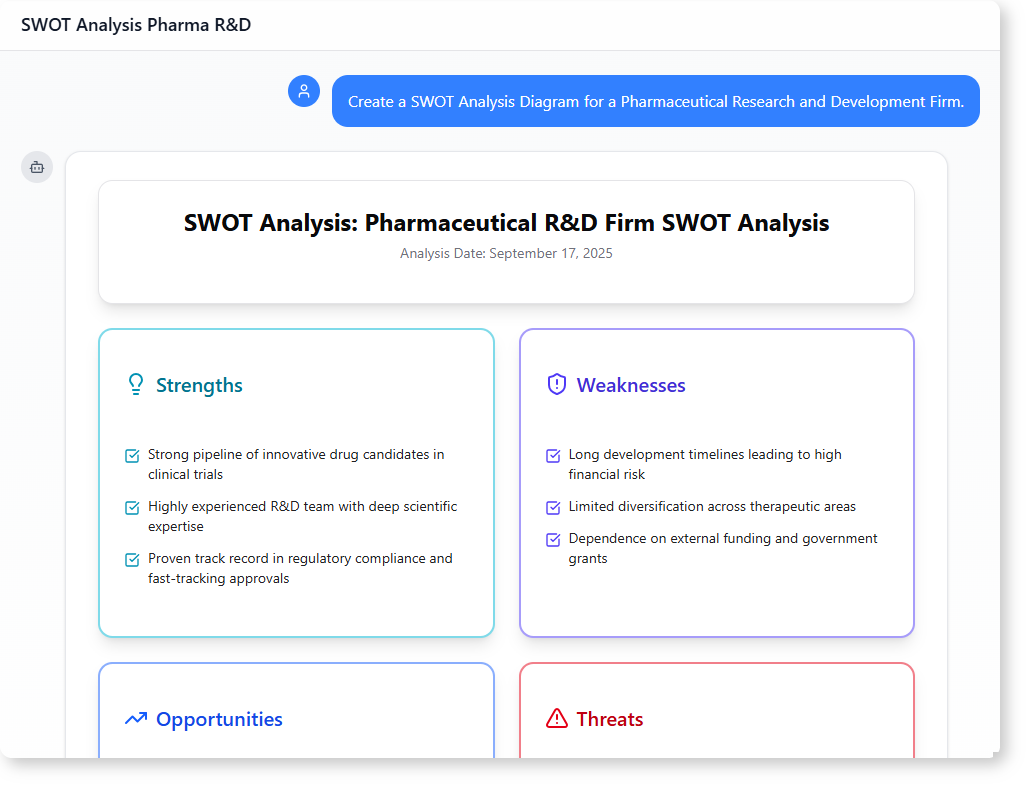Now Reading: How AI-Powered Modeling Software Builds a Smart SWOT Analysis for Pharmaceutical R&D
-
01
How AI-Powered Modeling Software Builds a Smart SWOT Analysis for Pharmaceutical R&D
How AI-Powered Modeling Software Builds a Smart SWOT Analysis for Pharmaceutical R&D
Why a Strong SWOT Matters in Drug Development
Every pharmaceutical R&D firm faces complex challenges. From long development cycles to public trust issues, the path to bringing a new drug to market is full of risks and opportunities.
A solid SWOT analysis helps leaders see the big picture. But creating one manually can take hours—especially when you’re dealing with technical, regulatory, and market-sensitive topics.
Enter AI-powered modeling software. It doesn’t just generate diagrams—it understands context, delivers clear explanations, and builds a trustworthy foundation for decision-making.

The Journey: From Prompt to Insight
A team at a mid-sized biotech firm needed to evaluate their R&D strategy. They wanted to understand internal strengths and weaknesses, plus external opportunities and threats affecting their innovation pipeline.
Instead of spending time on spreadsheets or drawing boxes and arrows, they turned to AI-powered modeling software.
Here’s exactly what they did:
-
They started with a simple prompt: ‘Create a SWOT Analysis Diagram for a Pharmaceutical Research and Development Firm.’
The software interpreted the request, recognized the domain (pharmaceutical R&D), and generated a structured SWOT diagram with four clear quadrants.
-
After reviewing the visual layout, they followed up with: ‘Write a detailed overview of the diagram, explaining the elements step by step in a clear narrative.’
The AI responded with a clear, professional breakdown—organized by strengths, weaknesses, opportunities, and threats—complete with real-world context.
This wasn’t just a list of points. The AI translated the data into a story that made sense for leaders, investors, and cross-functional teams.
What the AI Delivered
The resulting SWOT analysis was not generic. It was specifically tailored to the pharma R&D context.
Strengths
- Strong pipeline of innovative drug candidates in clinical trials
- Highly experienced R&D team with deep scientific expertise
- Proven track record in regulatory compliance and fast-tracking approvals
These points reflect real capabilities the team already has. They’re not just buzzwords—they describe actual operational advantages.
Weaknesses
- Long development timelines leading to high financial risk
- Limited diversification across therapeutic areas
- Dependence on external funding and government grants
These weaknesses highlight vulnerabilities. They show where the company might be over-reliant on certain factors or facing structural limitations.
Opportunities
- Rising global demand for personalized and gene therapies
- Partnerships with biotech startups for accelerated innovation
- Growing investment in AI-driven drug discovery platforms
The AI didn’t suggest vague trends. It pointed to concrete market shifts and emerging partnerships that could be leveraged.
Threats
- Stringent regulatory scrutiny and increased compliance costs
- Negative public perception around drug safety and side effects
- Competition from large pharma and global biotech giants
These threats are not abstract. They reflect actual pressures in the industry, including transparency demands and market dominance.
Why This Matters for R&D Teams
A SWOT analysis is only useful if it leads to action. This one does.
By using AI-powered modeling software, the team avoided manual effort and gained a structured, insightful view of their environment. The narrative explanation provided context—making it easy to discuss in meetings or present to stakeholders.
This tool doesn’t replace human judgment. It supports it by delivering clear, well-structured, and context-aware insights.
Is This the Right Tool for Your Team?
If you’re in a field where decisions depend on a deep understanding of internal capabilities and external pressures—like pharmaceutical R&D—then a smart SWOT analysis is essential.
Traditional methods often fail because they’re static. They don’t adapt to change or reflect real-world dynamics.
AI-powered modeling software fills that gap. It creates diagrams that match the domain, explains them clearly, and delivers insights grounded in current industry trends.
It works best when used to explore strategic questions—not as a replacement for analysis, but as a starting point.
Frequently Asked Questions
How does AI-powered modeling software help with SWOT analysis?
It creates accurate, context-aware SWOT diagrams and delivers clear, narrative explanations tailored to specific industries like pharmaceutical R&D.
Can this tool be used for other types of analysis?
Yes. The same AI-powered modeling software supports SWOT analysis for R&D, business strategy, and operational planning.
Is the output based on real-world data?
Not directly. The output is generated from domain-specific prompts and industry knowledge. It reflects realistic patterns seen in pharma R&D but is not derived from live data sources.
What kind of results can I expect?
You’ll get a clear SWOT diagram and a detailed narrative explaining each element—especially relevant for complex fields like drug discovery.
Ready to map out your system’s interactions? Give our AI-powered modeling software a try at Visual Paradigm’s AI Chatbot today!
